The Pendlay Row can help you gain overall strength to enhance all of your lifts in the gym. This exercise builds a bigger back. It also increases the range of motion much more than a regular barbell row. If you've never done a barbell Pendlay row , it's time you learned it. This move was created by American trainer Glenn Pendlay. It is a rowing variant specially designed to develop strength and back muscles with a pulling movement.
Use the Barbell Pendlay Row to Improve Your Bench Press
This row is the antagonistic exercise to the bench press (the reverse movement). Improving your strength on the Pendlay row will help you lift more pounds on the barbell bench press. In fact, you should ideally be lifting roughly the same weight on both exercises. This exercise also improves the snatch, clean, and deadlift. If you do the technique correctly , you can transfer the strength achieved to weightlifting or deadlift exercises.
Follow our complete guide to the Pendlay exercise , which will be very useful for you in a variety of strength and power sports. We'll present you with options, variations, and programming suggestions for this move.
What muscles does the Pendlay row work?
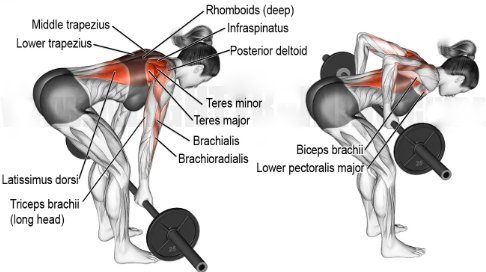
The Pendlay row primarily targets the muscles of the upper back and mid back . The exercise works the rhomboids and the lats . The latissimus dorsi emerges from the middle and lower back. These muscles connect the upper arms to the torso. They are the wing-shaped muscles on the side of your upper back. It is the largest muscle in the back and plays an important role in lat pulldowns, pull-ups, and other pulling or rowing exercises. The rhomboids are in the upper part of the back. These muscles contract and bring the shoulder blades together at the top of each repetition of Pendlay.
Additionally, the row is an excellent compound exercise that works other secondary muscles . Although we'll be doing the Pendlay row primarily as a back exercise, the movement engages muscles from all over the body. For example, the middle trapezius , which is the central part of the diamond-shaped muscle in the upper back. The middle trapezius works with the rhomboids to bring the shoulder blades together.
The exercise strengthens the rear deltoids , which are the rear of all three parts of the deltoid. The biceps brachii is the main muscle at the front of the upper arm (generally called the biceps). Your erector spinae are also involved; these are the muscles of the lower back. Additionally, the Pendlay row engages the abdominal, gluteal, and leg muscles . These muscles work statically or isometrically to stabilizeyour body and stay in position while doing the exercise. Your glutes, hamstrings, and other leg muscles play an important role in stabilizing your body in the bent-over position. The legs have more input in the cheat version of this exercise.
Pendlay rowing technique
Learn how to do the Pendlay row with the correct technique. Every time you "play" with an unknown exercise, you must first know the correct way to do it. Lucky for you, we have a detailed guide on how to perform this row.
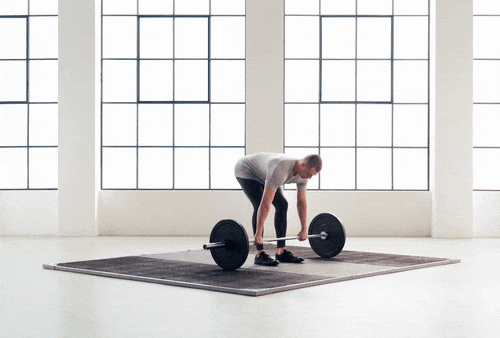
1. Position yourself:
Put the bar on the ground and use a grip slightly wider than shoulder-width apart. Position your hips like a deadlift, but a little higher. Your legs should be between your arms. In the starting position, try to keep the bar slightly away from your shins, to avoid hurting yourself when you raise the bar. When you grab the bar, your arms should be straight.
Recommendation: You should maximize lumbar extension. Imagine that you are stretching your back enough to increase the tension in your back and thigh muscles.
2. Pull the bar:
You want to keep your abs tight and push your feet into the ground to explosively pull the bar up . Bring the bar to the lower end of your chest (where your pectorals and abs meet). Be sure not to raise your shoulders or allow your hips to drop forward.
Recommendation: Imagine that you want to push your feet against the ground with all your might. Think about pulling the bar up toward your hips.
3. Lower the bar:
Extend your arms until the plates of the bar touch the floor. Bring the plates to rest completely on the floor before doing another rep. Then do the next rep.
Breathing : Fill your lungs with air before pulling the bar. Breathe out when the bar touches your chest.
Is the Pendlay row harmful?
Not if the correct technique explained in the guide is applied.
How to use the Pendlay row?
Although the row is a compound movement, it is usually used as an extra exercise . This means that it is not necessary to use it to carry maximum weights. However, it can come in handy to increase strength. This is because you will have to apply maximum force on each repetition. This exercise develops great power because you have to pull the bar from a complete stop. It is also a good option if you want to build muscle and increase muscular endurance. Here are several ways to use the rowing technique.
- • Test for maximum strength : Do 3-5 sets of 4-8 reps with a sub-maximum weight. The load should feel heavy.
- • Gain muscle volume r: Perform between 3 and 4 series of about 8-15 repetitions with a medium weight.
- • Increase muscular endurance : Do as many repetitions as you can for more than 2 minutes. Take necessary breaks between repetitions.
Mistakes to Avoid When Doing Pendlay Row
This exercise is quite a challenge. You must maintain a strong hip hinge throughout the lift. Also, you wouldn't have to use impulses to help you start each rep, except if you're doing the Pendlay cheat row. . In all rowing exercises in the gym, there are some common mistakes.
Bad back posture
It is true that, at times, cheating can increase profits. However, without good hip support, you shouldn't do it. You may be tempted to straighten your back during the Pendlay, pull your arm excessively, or raise your shoulders above your hips. These movements could cause your back to jerk up. They will also make it difficult for you to maintain hip integrity, which is an important part of performing the Pendlay row as effectively as possible.
Avoid these mistakes by learning good form on the Pendlay row by using light weight at first. Prepare for each rep by rolling your shoulders back and down. Then, squeeze your shoulder blades together to start the pull. Also, focus on keeping your hips relaxed.
Losing form as rep range changes
Ideally, to get the most out of this exercise, you want to focus on doing the pull strictly with your back. Some athletes try to lift more weight by taking momentum and keeping their back straight. It is always better to choose controllable weights, which allow you to leave your back parallel to the ground. This will avoid injuries, especially if you are a beginner.
Then, we will see the technique of the Pendlay trap row technique , which can be interesting when you're more advanced.
Pull elbows out to the sides
It is not necessary for your elbows to be completely close to your body during the execution of the row. Long arm lifters may need to open their elbows a bit for comfort. However, do not overdo this gesture, as you could damage your shoulders. In addition, you will put all the stress of the exercise on the arms and shoulders.
If you find that you are pulling your elbows out to the sides too much, you should use a lighter weight. Force yourself to bring your elbows in toward your body and bring the bar toward your hips. Experiment a bit until you find the right move for you.
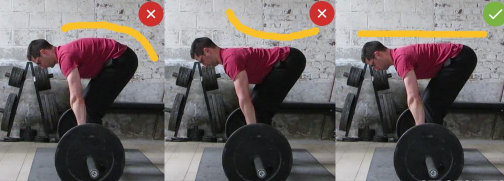
Lift the bar with your arms, instead of your back
The Pendlay Rowing is meant to develop your back muscles, not your arms. Too many lifters bend at the wrists to lift the weight almost exclusively with their arms. This may happen because there is too much weight on the bar. Using arm strength to gain momentum causes a "bounce" at the top of the rep. You could hurt your wrists and back. The key, as always, is to put on a weight you can handle and learn the technique well.
Arching
Rounding the back is another classic rowing mistake . It usually occurs due to poor initial posture. It can also happen during the set, if you don't keep your back compact. Remember to keep your chest up and your spine straight during all repetitions of the Pendlay Row . Keeping your back straight will not only prevent injury, but will increase the effectiveness of this exercise.
Move too much weight
If you feel like you need to excessively change your back angle or push yourself to lift the load, you may have put too many plates on the bar. Don't get depressed if you don't lift a lot of weight at first in this exercise! The sooner you get into perfect shape with a light load, the sooner you'll be able to use more discs. What to do to keep progressing in Pendlay rowing without increasing the weight? Try to put the same weight and increase the number of quality repetitions. When you reach a certain target number of reps (for example, 15), gradually increase the weight.
Pendlay row variants
If you're looking for new ways to improve back strength and hypertrophy, check out alternatives to the Pendlay row . Power gains in your back muscles.
Cheated Pendlay row
As we indicated, it is better to maintain the correct and basic technique for most of the time. However, not everything is black or white. If you've been doing this exercise for a while and have learned the proper technique, you can "cheat" a bit to maximize your results.
In this case, it is about starting the takeoff by doing some impulse with the legs; rolling your hips back and squatting down again. The movement is like you would do a leg drive in a deadlift. This will give you enough explosiveness to facilitate the first part of the movement. Afterwards, you can straighten your back a bit to make the final pull easier.
Well, this trick allows you to carry more weight, give an extra stimulus to the muscles and gain more power. Don't abuse the trap.
Pendlay with blocks
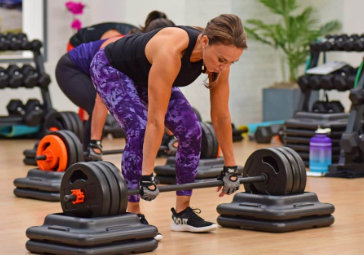
This variant of the Pendlay row reduces the range of motion of the bar. If you don't have good mobility, this adjustment can help you get into a more comfortable starting position. It also serves to improve your stagnation points. For example, if you struggle with the upper part of the movement, you can use more weight with the blocks to improve in that area.
Touch-And-Go Pendlay row
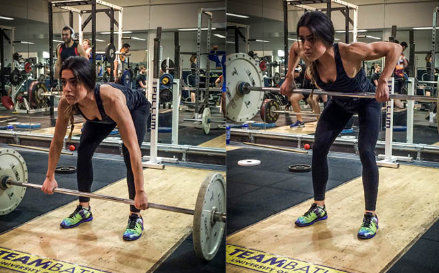
Use this variation only to be able to do more repetitions and if you are going to maintain the correct technique at all times. This consists of touching the ground and raising the bar quickly , instead of stopping the plates completely on the ground (normal version). With this technique, you will be able to do many more repetitions in the same series and, therefore, gain more hypertrophy. Be very careful; do not hit the discs against the ground violently (give only a light tap).
Touch and go reps are useful if, and only if, you use them to help you hit more reps while maintaining good form. They can help you increase the number of repetitions in each set for more overall growth.
Pendlay Row Underhand Grip

The basic version of the exercise is the overhand grip Pendlay row . It consists of grabbing the bar with the palms of the hands facing the body. Thus, you involve the back and not so much the biceps.
On the other hand, there is also the variant of the Pendlay with an underhand grip . In this version, you grip the bar with your palms facing out, much like you would grip a bar to do bicep curls. The rest of the exercise is as we have explained in the guide. This version of the movement strengthens the biceps more.
In which variant is it possible to move more weight? In prone or supine? This depends on you. Try both.
Pendlay row with deficit
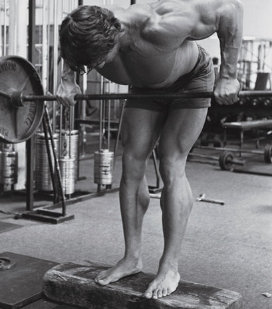
It is a way of complicating the exercise on purpose . You climb on a block to lengthen the course and start from a disadvantaged position. Lengthening your range of motion allows you to stretch your muscles and increase the amount of time under tension.
Rowing as a deadlift warm-up
This is more of a strategy, which is to do a few sets of Pendlays before your deadlifts. You will accumulate a certain volume of work with light weights. You will warm up the thighs, lower back and upper back.
How to apply it? When doing your deadlift warmup with weights that are less than 50% of what you'll be lifting that day, do 3-5 reps of the Pendlay Row each set.
Alternatives to the Pendlay rowing
Although the standard Pendlay row is an excellent exercise, the variety of exercises is crucial to achieve optimal progress. We'll show you some alternatives to the Pendlay row that you can use to spice up your workouts.
Other barbell rows
We propose three alternatives to barbell rows that you can try to work your back:
• Oar Seal: You have to lie face down on a flat bench. Grasp the bar with your arms straight and pull it towards the bench using the strength of your back. Catching the bar is a bit difficult, but it is a very effective exercise because it does not allow you to cheat.
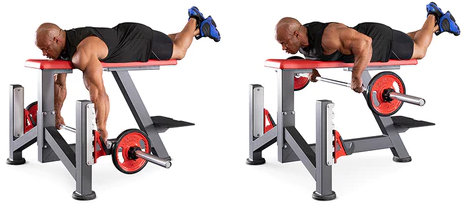
• Bent-over barbell row: This is the most similar alternative to the Pendlay, but the weight does not rest on the ground after each repetition. You'll have to support the weight with your arms throughout the set, which engages your lower back and hamstrings more. Therefore, use less weight and do more repetitions in this exercise.
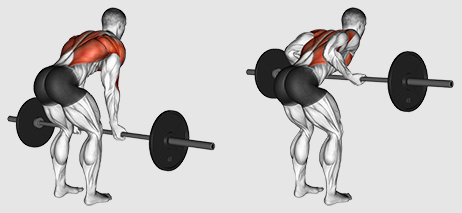
• T-Bar Row: In this case, a narrow grip is used. It starts with the body bent and the arms outstretched. You have to pull the bar until you bring the discs to the lower part of the pectoral. You will need a T-bar mount.
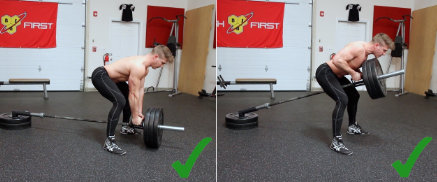
Dumbbell or Kettlebell Pendlay Rows
Although the dumbbell Pendlay row is more difficult to do, it allows your muscles to work through a greater range of motion. This exercise can be done in several ways:
• Dumbbell Pendlay: Using dumbbells is useful when you need to identify and correct imbalances in back strength from right to left. Balance is not only important for aesthetics. If the imbalance is not addressed, it can increase the risk of injury. If you don't have dumbbells, you can do the Pendlay row with kettlebells .
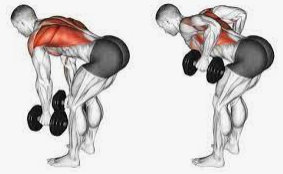
- Place two dumbbells on the floor, shoulder width apart and with the handles parallel. So you can take them with a neutral grip.
- Stand in front of the dumbbells with your knees slightly bent.
- Use the same position as in the barbell Pendlay row. Bend at the hips, lean forward, and reach for the dumbbells.
- Keep your abdominal muscles tense, your back straight and your torso parallel to the ground.
- Raise the dumbbells up to the ribs. Roll your shoulders back and keep your upper arms close to your sides.
- Lower the dumbbells or kettlebells to the floor, stop them and do another repetition.
• Alternating Pendlay with dumbbell or kettlebell:
This variation allows the upper body to work without putting as much stress on the lower back. Don't overdo it by using heavy weights, as they do more harm than good. When you alternate arms, the non-working arm will only provide limited support. Lifting just one dumbbell per rep requires less effort on the lower back.
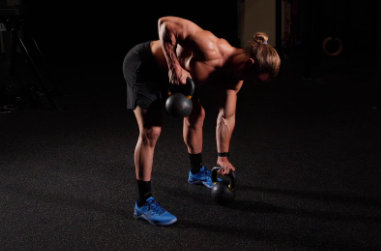
- Use the same starting position as in a normal row with dumbbells.
- Place two dumbbells on the floor, shoulder width apart, with the handles parallel so you can use the neutral grip.
- Stand in front of the dumbbells with your knees slightly bent.
- Use the same stance as in the Pendlay barbell row. Bend at the hips, lean forward, and reach for the dumbbells.
- Tense your abdominal muscles, keep your back flat and your torso parallel to the ground.
- Grasp the left dumbbell with your elbow slightly bent and pull up and to your side. Keep your upper arm close to your torso.
- Lower the dumbbell and bring it to the ground.
- Now, you have to repeat the movement with your right hand. She continues to alternate arms throughout the set. After each rep, she lets the weight rest firmly on the floor. If the weights aren't resting flat on the floor, you'll be lifting them with inertia, rather than muscle.
• Single Dumbbell or Kettlebell Unilateral Pendlay Row: Don't worry if you only have one dumbbell. You can use a single dumbbell in the set to work your lower back, upper back, and biceps with Pendlay rows. This variant even works the abdominal muscles.
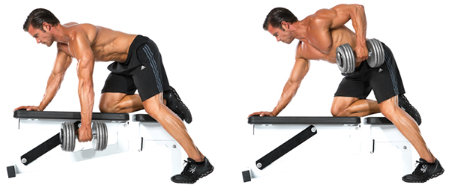
Do this variation in the same way as the regular dumbbell Pendlay row, but with only one arm at a time . It is important to do the same number of lifts with each hand to avoid developing one side of the muscle more than the other (except when working with unbalanced muscles).
Pendlay Cable Row
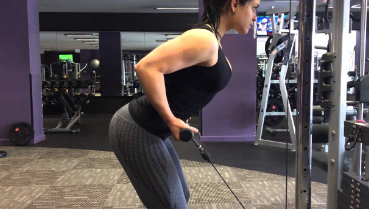
To do the Pendlay cable row, you'll need to switch to a low cable machine . Hook a long handle onto the pulley. Due to the position of the cable, you may not be able to be as parallel to the ground as in the conventional free-weight row. It may be best to position yourself with your back to the pulley. The cable should go under your legs.
Pendlay Rowing with Multipower
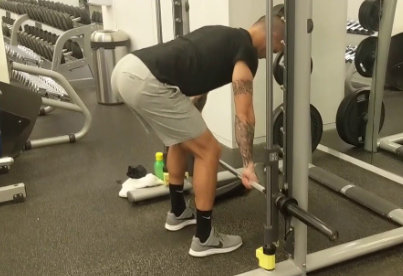
On the rail Smith machine, you can do the regular barbell row and the pendlay. Place yourself in the same position that we have taught you in the guide. Pull the bar of the Multipower to the lower area of your chest and descend until you touch the top of the machine. Rest the bar completely, take a breath and pull it again. Don't overuse the Pendlay row on the Multipower . Use it only as a complement, as this machine compromises freedom of movement.
Pendlay on machine
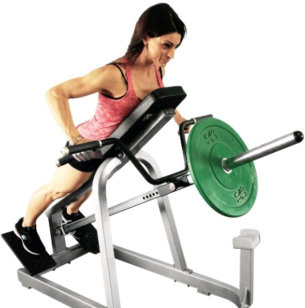
In some gyms, you'll see the T-bar row machine for placing weight plates. Some of these machines have a wide grip, thanks to which you can simulate a movement similar to that of the Pendlay rowing. When you decide to do machine pendlay rows , let the rack rest fully on the floor after each rep. Try to make the movement resemble how you would do it with a free weight.
Rowing with the weight in height
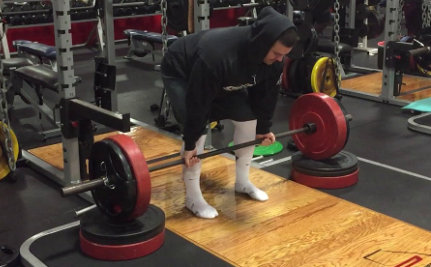
This variant is very interesting. Many lifters find it nearly impossible not to arch their backs when doing sets of rows. Rounding the back puts too much stress on the ligaments and intervertebral discs in the spine. Also, if your hamstrings are under tension, you'll have a hard time leaning forward and keeping your back straight. However, there are still other ways to get the benefits of the Pendlay row .
You can raise the bar in several ways:
- • Stack some weight plates on the floor and have the barbell plates rest on top.
- • Place sturdy stepping blocks under the discs.
- • Pull the bar from a higher height thanks to the safety supports of a power rack.
You can use these tricks to do dumbbell, barbell, and single dumbbell Pendlay rows. While this modification can be beneficial, you should practice stretching and hamstring flexibility on the side. The goal is that one day you will be able to do the real Pendlay row by pulling the bar off the ground.
Benefits of Pendlay Row Exercise
What advantages will you get from doing this exercise?
Increases the thickness and strength of the back
Whether you want to develop a strong back for cosmetic reasons or gain strength for other lifts, it's important to train with specific volume, load, and contractions . The Pendlay row allows you to load the bar with a relatively high weight compared to other back-specific movements. The exercise forces you through the full range of motion to increase back hypertrophy.
Improve your squat and deadlift
The ability to contract and prepare your back is essential to maintaining good posture during movements like the deadlift, front and back squats, and even the bench press. Lifting heavier weights in these exercises requires a powerful back.
Improving the capabilities of your back in powerlifting is possible if you add Pendlay rowing to your routine. Since each rep is done pulling the weight up from the floor, you'll have to contract your back each time you lift the bar. This is a great exercise for powerful power lifts.
Increase your pulling force
For strength athletes, doing the Pendlay row should be a top priority. This is especially true if you lack postural strength in your hamstrings and back. The Pendlay row is excellent for building static and concentric strength, which are necessary during the snatch and clean and jerk, as well as breaking sticking points in power lifts. The Pendlay can help with squats and deadlifts because it increases lower and upper back strength.
Rowing activates all the muscles of the body
Exercise activates almost every muscle and ensures your overall fitness, stability, and balance. Also, to execute it, it is not necessary to use benches, ropes or cable machines. The muscle strength you gain from the Pendlay sets will help you perform other compound exercises.
When you strengthen your lats, traps, rhomboids, deltoids, and spine with the Pendlay row, all other compound exercises will be child's play. You will also have better forearms, grips, core stabilizers, glutes, and hamstrings.
Include this row in your training program. The muscle tone you'll gain will help you perform pull-ups, deadlifts, barbell rows, lat pulldowns, hammer curls, powerlifts, bench presses, squats, and more.
What is the difference between the Pendlay row vs. the barbell row?
The main differences between the two oars are the starting position and the characteristics of the pulling movements. In the Pendlay, the back is positioned more or less parallel to the ground. For this reason, it is more difficult to get into the correct starting position than other types of rowing.
In the Pendlay version, the plates have to touch the ground, while in the conventional barbell row the plates are in the air. Therefore, the conventional barbell row requires a little more grip strength. In addition, in the conventional row, the back is more inclined and not so horizontal with respect to the ground.
The Pendlay row is also perfect for improving moves like the clean or deadlift. This is because the bar starts from a static position on the ground . You have to pull the bar up without your hips moving up or down. This promotes a strong posture and a better starting position for those more advanced exercises.
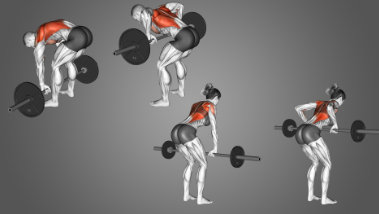
Is it a good idea to do Pendlay rows with dumbbells or kettlebells?
Although the Pendlay was originally designed to use a barbell, it has evolved over the years. For this reason, you can also use dumbbells or kettlebells. However, some people still argue that the Pendlay row is for the bar and that any other variant is simply a bent over row.
How do I keep my pelvis from moving during a Pendlay row?
If you find it difficult to keep your pelvis in place, focus on locking your knees and pelvis into a flexed position. Push your feet hard into the ground and lock your core before lifting. If this doesn't correct the movement of the pelvis, you may simply need to use less weight.
Is the Pendlay row harmful?
No. If the proper technique we have explained is maintained, anyone can reap the benefits of the Pendlay row . Intermediate and advanced lifters can use it. Strength and power athletes can greatly benefit from incorporating the Pendlay into their strength and hypertrophy training.
• Powerlifters and Strongmen : The exercise serves as a targeted workout for the hips and back, which play a crucial role in the deadlift. Lifters will improve your lumbar stability in the hip hinge position. As a result, they will develop a stronger deadlift.
• Weightlifting Lifts : Rowing can be used as an auxiliary movement to build strength and musculature in the lower back and upper back. By increasing isolation of the hips and back, lifters can use the additional load to promote muscle hypertrophy throughout the full range of motion.
• All audiences : All athletes in general, even those who do not plan to compete, can use specific exercises for the back. With them, they will improve posture, physical performance and reduce the risk of injury.
However, the Pendlay row isn't as suitable for most beginners as it requires flexibility and proper mechanics at the hip joint (which doesn't always come naturally to people). If you're new to weightlifting, start with seated row variations (such as the cable row on the chest-supported machine).
Bodybuilders say, "If you want to grow your back, you have to do rows!" Lat pulldowns are great back exercises, but neither will give you optimal strength and size compared to rowing.
You have many rowing exercises to choose from, including the traditional barbell row, the cable row, the bodyweight row, and the machine row with chest support. However, the Pendlay row is perhaps the best alternative. Add it to your training and you will see how your back grows!





![LAS MEJORES MÁQUINAS DE MUSCULACIÓN PARA PRINCIPIANTES [GUÍA 2025]](/modules//smartblog/images/no-home-small.jpg)
![HOW TO BUILD A HOME GYM ON A BUDGET [2024 GUIDE]](/modules//smartblog/images/296-home-small.jpg)


